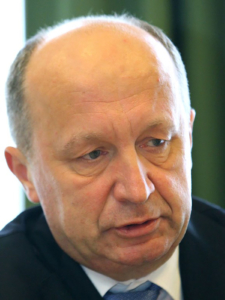From 1949 to 1951, the U.S. plowed $12.7 billion ($135.4 billion in 2017 dollars) into rebuilding the Europe economy, which had been shattered by the World War II. Under the European Recovery Program (known as the Marshall Plan, after its author, then-U.S. Secretary of State George C. Marshall) the three biggest recipients of that aid, Britain, France, and West Germany, got 26 percent, 18 percent and 11.3 percent of that sum respectively.
Now Ukraine, beset by war and economic distress, could get a Marshall Plan of its own: A joint Lithuanian-Ukrainian initiative, known as the Investment Plan for Ukraine, suggests that the European Union and G7 countries provide Ukraine with up to $5 billion per year for 10 years to rebuild economy.
Ukraine plans to present the plan during the Eastern Partnership Summit in Brussels on Nov. 24.
The money would come with strings attached: The donors would monitor how effectively the money was used, and failures to meet benchmarks would cut off the influx of funds.
If the plan is supported and the money is used wisely, experts reckon Ukraine’s economy could grow annually by 6–8 percent over the next 5–10 years. The country’s gross domestic growth in 2016 grew by just 2.3 percent, standing at $93 billion.
Hanna Hopko, member of the Ukrainian parliament and the head of the parliament’s committee on foreign affairs, told the Kyiv Post on Nov. 15 that the Ukrainian people would feel the results of the plan.
“We need that money to make the Ukrainian economy finally grow, so that Ukrainian people could at last see an improvement in the country,” Hopko said. “Not just reforms on paper, but better roads, bigger salaries and so on.”
Clear results
Since 2014, Ukraine has been pledged more than 12.5 billion euros ($14.7 billion) in financial aid from various international financial organizations of the European Union. Also, Ukraine has already received $8.5 billion out of its $17.5 billion program of financial help from International Monetary Fund.
However, most of that has gone to propping up the economy to prevent collapse, rather than fostering growth.
“Most of all the financial aid we’ve got before went to Ukraine’s gold reserves in order to strengthen the Ukrainian hryvnia so that investors could be sure there would be no economic collapse in Ukraine,” Hopko said. Since 2015, Ukraine’s gold reserves have grown from $5.8 billion to $18 billion.
“But the Ukrainian people can’t see any progress in the country, as those funds didn’t go to the economic sectors,” Hopko added. “Soon they might get disappointed in the pro-European course, and that might let the ‘Russian World’ get back here quickly,” she added, referring to Ukraine slipping back under the influence of the Kremlin.
Still, many in Ukraine and the EU are cautious about the plan, which would envisage investments of at least $30 billion into infrastructure, energy efficiency, and other key areas to improve the Ukrainian economy and business climate.
“The EU will keep supporting Ukraine anyway,” Johannes Hahn, the commissioner on European Neighborhood Policy & Enlargement Negotiations, said during the Civil Society Forum in Estonia, news website European Pravda reported on Oct. 26.
“But we won’t give the money without any clear results,” Hahn added. “Sorry, but the level of trust in Ukraine is not very high. So we will pay only if we see that something has been done.”
Hahn couldn’t ensure that the new Investment Plan for Ukraine would even be adopted by the European Commission, and said Ukraine doesn’t need a Marshall Plan but a change in its business climate to attract investments.
Yet proponents of the plan say it could stimulate the Ukrainian government to adopt much-needed reforms in the country. And it has a geopolitical significance as well, according to the draft Ukrainian Marshall Plan, which was initially created by three Lithuanian politicians in 2016: A successful implementation of the plan would represent a win for the West in its conflict of socio-economic models with Russia. Along with Ukraine, Lithuania has been actively promoting the plan in various institutions of the European Union.
No return to Russia

Former Lithuanian Prime Minister Andrius Kubilius. (AFP)
The New Investment Plan for Ukraine was created by Andrius Kubilius and Gediminas Kirkilas, former prime ministers of Lithuania, and Petras Vaitiekūnas, the country’s former foreign minister.
The authors have tailored the plan to motivate Ukraine to stick to its pro-Western course and reform the key areas of its economy. This would allow further European integration, even amid the withdrawal of the United Kingdom from the EU and “fatigue associated with United Europe project.”
While the West and EU are mired in their own problems, the Kremlin has already managed to slow the pro-Western progress of Georgia, while a pro-Russian president, Igor Dodon, has been elected in Moldova, the plan reads.
Lithuanian support
Ukraine has lost trust among many of its partners in Europe by stalling its reforms, failing to fight corruption, and bickering with neighboring Poland, Hungary, and Romania over changes to its education law.
Asked why Lithuania continues to support Ukraine, Kubilius told the Kyiv Post on Nov. 14 that Ukraine’s success is important for the security and development of the whole Europe.
“We understand what challenges Ukraine is facing: military aggression, an unreformed economy,” Kubilius said. “Also we had a similar path of reform back in the 1990s, so we know that nobody can improve the country in one night or one year. It will take time. Ukraine has made a lot of progress since the EuroMaidan Revolution (of 2013–2014).”
But the plan’s Lithuanian authors are not naïve; money from the Marshall Plan for Ukraine will only be doled out if there are results.
“The money will come to Ukraine only if the Ukrainian government continues to improve the country and shows concrete results,” he said.
Money management
Hopko said that the Marshall Plan would not only help Ukraine financially, but also create effective mechanisms to manage the funds in Ukraine. According to a recent report by the Audit Chamber of Ukraine, EU loan money is still being used ineffectively.
“For example, we have a 400 million euro loan that the European Investment Bank allocated to support small farming businesses in Ukraine,” Hopko said. “The Rada (parliament) ratified it back in September 2016, but farmers still have no access to that money and don’t know where to ask for it.”
That’s because the Finance Ministry and the Agriculture Ministry could not decide which institution would manage the money, Hopko added. In April, Former Agriculture Minister Taras Kutoviy (who resigned in May) said the ministry would start allocating the money to famers in the second half of 2017.
To prevent such situations, Ukraine’s Marshall Plan would set up several financial monitoring institutions, where representatives of international financial organizations would oversee the timely allocation of funds.
Eastern Partnership
This year’s 5th Eastern Partnership Summit will focus on what has been achieved since the last summit in Riga, Latvia in 2015, especially on the benefits delivered to citizens of the six Eastern Partnership countries (Ukraine, Azerbaijan, Armenia, Belarus, Moldova, and Georgia).
The Marshall Plan for Ukraine is not on the summit’s agenda, but it may be discussed during a bilateral meeting at the summit between Ukrainian President Petro Poroshenko and European Council President Donald Tusk, the European Council press service told the Kyiv Post on Nov. 15.
However, Kubilius is still promoting aid for Ukraine in the EU. He said that a week ahead of the summit, the European Parliament would adopt a special resolution with a paragraph dedicated to the new European Investment Plan for Ukraine, Moldova and Georgia.
EU leaders will also discuss at the summit the extension of the EU’s External Investment Plan — an initiative to encourage investment from the EU into African and EU neighborhood partner countries. However, the discussions will not focus on any specific country, the European Council press service said.
EU wants better results from its financial aid to Ukraine
Since 2014, the European Union has pledged 12.5 billion euros in financial support to help Ukraine’s struggling economy in exchange for reforming the country.
Although European partners are in general satisfied with pension, health and other reforms adopted by the Ukrainian government, they want see better overall results.

Deputy Director General at DG Neighborhood and Enlargement Negotiations (DG NEAR), European Commission Katarina Mathernova. (Courtesy)
Katarina Mathernova, the European Commission’s deputy director general for Neighborhood Policy and Enlargement Negotiations, told the Kyiv Post on Nov. 16 that the EU needs to consolidate its financial aid for Ukraine, which would help it attract new resources.
“We do see a need to communicate a lot better,” Mathernova said. Currently, she said, the EU’s help is scattered among numerous programs.
A proposed joint Lithuanian-Ukrainian initiative created in April offers to take care of that problem suggesting that the European Union and G7 countries provide Ukraine with up to $5 billion per year over a 10-year term, a project dubbed the “Marshall Plan for Ukraine.”
Mathernova sees the Lithuania-Ukrainian initiative as a good way to stimulate the EU to construct a roadmap to attract big investors into Ukraine.
It is too early, however, to talk about the specific amount of financial aid, Mathernova said. For her, the quantity of money is not as important as getting various players to work towards the same goals and to push for the kind of reforms that are absolutely necessary to attract investments. These include the “effective protection of property rights, contract enforcement, credit rights and all the other things that really attract external investments.”
The Lithuanian plan also drew the EU’s attention to the fact that a lot of the funds it has already provided to Ukraine are stalled at various stages in different projects.
To counter this problem, the Marshall Plan envisages the setting up of institutions that would monitor the implementation of programs.
But Mathernova is not sure this is a good idea, as the creation of new institutions takes time and is not necessarily more efficient.
“It is much more important to improve the capacity of the relevant ministries to manage the recourse and provide them more quickly either to private actors or municipalities,” she added.
Mathernova is optimistic regarding Ukraine’s overall reform process and does not believe that it has stalled.
“Everybody in Ukraine wants changes to happen yesterday. The amount of reforms that have already been carried out in Ukraine is quite extraordinary,” she says. “You need to continue, and to protect the reform achievements, because otherwise you will roll back.”
